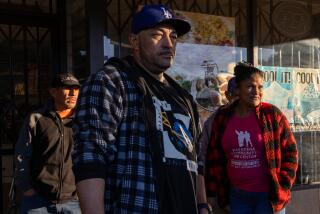U.S. Accused of Stealing Body Parts : Uranium: Widow contends Energy Department workers took the evidence that her husband died of uranium poisoning--bones, liver, kidney and spleen tissue. Government denies wrongdoing but admits taking the items.
- Share via
CINCINNATI — They came the day after Larry Hicks’ heart stopped, and when they left they took bones and liver, kidney and spleen tissue. It was, says his widow, a “clandestine and ghoulish operation.”
Hicks had worked at the Fernald uranium-processing plant for a dozen years; these “ghouls” were agents of the federal government. Diane Hicks is furious at the treatment her husband’s body received.
“We’re talking about a human being. We’re talking about the father of my children,” she said. “It’s just horrible. The public should know what they’re capable of doing.”
The U.S. Department of Energy says hundreds of current employees at nuclear-technology sites nationwide willingly agreed to donate their organs and tissue through a volunteer program.
The tissue samples and records stored at the U.S. Transuranium and Uranium Registries in Richland, Wash., are used to update radiation exposure standards and determine whether former employees or contract workers died as a result of radiation exposure, Energy Department spokesman Ken Morgan said.
But Diane Hicks and others say that the Energy Department arranged with coroners to quickly take away internal body organs of dead workers in order to destroy evidence and protect against lawsuits alleging the victims were killed by workplace exposure to radioactive substances.
Louise Roselle, a lawyer for Hicks’ widow, says there is no indication that Hicks or his family signed any consent form authorizing donation of the organs or of any body tissues.
Hicks, 33, worked at the Fernald plant near Cincinnati as an inspector. On May 8, 1985, an equipment failure dumped enriched uranium on him, Diane Hicks said.
Twelve days later, she said, her husband awoke feeling weak and ill. He sought treatment, but died of heart failure that day. The doctor who treated him told the coroner that the death was consistent with heavy metal poisoning.
Diane Hicks said the tissues were taken from her husband’s body without her knowledge or consent.
“They took whole organs, everything but the heart,” she said. “Since they didn’t talk to me and I didn’t know they were doing this, for whose benefit were they doing the test?”
She sued, but in 1986 a federal judge ruled that under Ohio law, the Hamilton County coroner had properly taken control of Larry Hicks’ body and had legally ordered an autopsy.
U.S. District Judge S. Arthur Spiegel also ruled then that National Lead of Ohio Inc., the Energy Department’s contract operator at Fernald, and the Hanford Environmental Health Foundation, also a DOE contractor, were protected by the same state law in offering assistance to the coroner.
Until 1992, the Hanford foundation operated the transuranium registry for the Energy Department. The registry, in operation since 1968 and home to tissues or records of nearly 700 current or former DOE contractor employees, has been operated since then by Washington State University.
Since her husband’s death, Diane Hicks has worked to support her two children, ages 15 and 13. She has fought unsuccessfully in court against National Lead, funded by the Energy Department, to collect workers’ compensation payments for her husband’s death.
National Lead argued that Hicks’ death was not employment-related. Diane Hicks’ lawyers argued that the government had taken away key evidence by removing internal parts from Larry Hicks. Diane Hicks lost her workers’ compensation bid, but has appealed to a state appeals court.
“They’ve fought me tooth and nail, every step of the way,” she said.
Other critics have decried the Energy Department’s “body snatchers.”
“It was a conspiracy between the government and its contractors to, in the most unethical and evil way, steal workers’ organs without their knowledge or consent, to successfully destroy the evidence so that the workers and their families would be unable to file workers’ compensation claims against the Department of Energy or its contractors,” said Dr. David Egilman, a former Cincinnati occupational physician and epidemiologist.
Tom Carpenter, a Seattle lawyer with the Government Accountability Project, a group that represents government whistle-blowers and investigates their allegations, also questioned the DOE program. Carpenter said that not all participants volunteered to donate organs to the Energy Department.
“They weren’t doing it for purposes of legitimate scientific research,” Carpenter said. “They were lying to their workers.”
But Morgan, the Energy Department spokesman, insisted the purpose was scientific research.
“All the autopsies were done by local coroners,” Morgan said. “Sometimes tissue was collected and then it was sent to DOE contract labs. . . . All of that data was sent to the Transuranium Registry.
“The DOE didn’t do anything here other than ask for some tissue samples and the data,” Morgan said.
More to Read
Sign up for Essential California
The most important California stories and recommendations in your inbox every morning.
You may occasionally receive promotional content from the Los Angeles Times.













